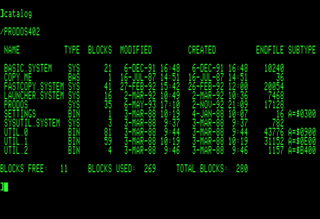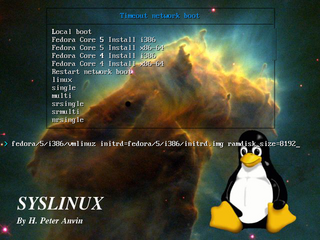Related Research Articles

A Linux distribution is an operating system made from a software collection that includes the Linux kernel, and often a package management system. Linux users usually obtain their operating system by downloading one of the Linux distributions, which are available for a wide variety of systems ranging from embedded devices and personal computers to powerful supercomputers.

FreeDOS is a free software operating system for IBM PC compatible computers. It intends to provide a complete MS-DOS-compatible environment for running legacy software and supporting embedded systems.

KNOPPIX is an operating system based on Debian designed to be run directly from a CD / DVD or a USB flash drive, one of the first live operating system distributions. Knoppix was developed by, and named after, Linux consultant Klaus Knopper. When starting a program, it is loaded from the removable medium and decompressed into a RAM drive. The decompression is transparent and on-the-fly.

ProDOS is the name of two similar operating systems for the Apple II series of personal computers. The original ProDOS, renamed ProDOS 8 in version 1.2, is the last official operating system usable by all 8-bit Apple II series computers, and was distributed from 1983 to 1993. The other, ProDOS 16, was a stop-gap solution for the 16-bit Apple IIGS that was replaced by GS/OS within two years.
A boot disk is a removable digital data storage medium from which a computer can load and run (boot) an operating system or utility program. The computer must have a built-in program which will load and execute a program from a boot disk meeting certain standards.
Disk formatting is the process of preparing a data storage device such as a hard disk drive, solid-state drive, floppy disk, memory card or USB flash drive for initial use. In some cases, the formatting operation may also create one or more new file systems. The first part of the formatting process that performs basic medium preparation is often referred to as "low-level formatting". Partitioning is the common term for the second part of the process, dividing the device into several sub-devices and, in some cases, writing information to the device allowing an operating system to be booted from it. The third part of the process, usually termed "high-level formatting" most often refers to the process of generating a new file system. In some operating systems all or parts of these three processes can be combined or repeated at different levels and the term "format" is understood to mean an operation in which a new disk medium is fully prepared to store files. Some formatting utilities allow distinguishing between a quick format, which does not erase all existing data and a long option that does erase all existing data.

A live CD is a complete bootable computer installation including operating system which runs directly from a CD-ROM or similar storage device into a computer's memory, rather than loading from a hard disk drive. A live CD allows users to run an operating system for any purpose without installing it or making any changes to the computer's configuration. Live CDs can run on a computer without secondary storage, such as a hard disk drive, or with a corrupted hard disk drive or file system, allowing data recovery.

The Syslinux Project is a suite of five different boot loaders for starting up Linux distros on computers. It was primarily developed by H. Peter Anvin.

Damn Small Linux (DSL) is a discontinued computer operating system for the x86 family of personal computers. It is free and open-source software under the terms of the GNU GPL and other free and open source licenses. It was designed to run graphical user interface applications on older PC hardware, for example, machines with 486 and early Pentium microprocessors and very little random-access memory (RAM). DSL is a Live CD with a size of 50 megabytes (MB). What originally began as an experiment to see how much software could fit in 50 MB eventually became a full Linux distribution. It can be installed on storage media with small capacities, like bootable business cards, USB flash drives, various memory cards, and Zip drives.

SystemRescue is a Linux distribution for x86 64 and x86 computers. The primary purpose of SystemRescue is to repair unbootable or otherwise damaged computer systems after a system crash. SystemRescue is not intended to be used as a permanent operating system. It runs from a Live CD, a USB flash drive or any type of hard drive. It was designed by a team led by François Dupoux, and is based on Arch Linux since version 6.0. Starting with version 6.0, it has systemd as its init system.
Ghost is a disk cloning and backup tool originally developed by Murray Haszard in 1995 for Binary Research. The technology was acquired in 1998 by Symantec.

The USB mass storage device class is a set of computing communications protocols, specifically a USB Device Class, defined by the USB Implementers Forum that makes a USB device accessible to a host computing device and enables file transfers between the host and the USB device. To a host, the USB device acts as an external hard drive; the protocol set interfaces with a number of storage devices.
In computing, data recovery is a process of retrieving deleted, inaccessible, lost, corrupted, damaged, or formatted data from secondary storage, removable media or files, when the data stored in them cannot be accessed in a usual way. The data is most often salvaged from storage media such as internal or external hard disk drives (HDDs), solid-state drives (SSDs), USB flash drives, magnetic tapes, CDs, DVDs, RAID subsystems, and other electronic devices. Recovery may be required due to physical damage to the storage devices or logical damage to the file system that prevents it from being mounted by the host operating system (OS).

BartPE is a discontinued tool that customizes Windows XP or Windows Server 2003 into a lightweight environment, similar to Windows Preinstallation Environment, which could be run from a Live CD or Live USB drive. A BartPE system image is created using PE Builder, a freeware program created by Bart Lagerweij.
IMG, in computing, refers to binary files with the .img filename extension that store raw disk images of floppy disks, hard drives, and optical discs or a bitmap image – .img.

A live USB is a portable USB-attached external data storage device containing a full operating system that can be booted from. The term is reminiscent of USB flash drives but may encompass an external hard disk drive or solid-state drive, though they may be referred to as "live HDD" and "live SSD" respectively. They are the evolutionary next step after live CDs, but with the added benefit of writable storage, allowing customizations to the booted operating system. Live USBs can be used in embedded systems for system administration, data recovery, or test driving, and can persistently save settings and install software packages on the USB device.
UNetbootin is a cross-platform utility that can create live USB systems and can load a variety of system utilities or install various Linux distributions and other operating systems without a CD.
Amiga support and maintenance software performs service functions such as formatting media for a specific filesystem, diagnosing failures that occur on formatted media, data recovery after media failure, and installation of new software for the Amiga family of personal computers—as opposed to application software, which performs business, education, and recreation functions.
DasBoot is a software utility produced by SubRosaSoft.com Inc. It allows the user to create a bootable Mac OS X USB device for Mac OS X 10.5 and earlier. It is a freeware product. This live USB device can be used for diagnostic, repair, and recovery of Mac OS X systems.
References
- 1 2 Computer Hope. "UBCD".
- ↑ Jack Wiles, Anthony Reyes. "The Best Damn Cybercrime and Digital Forensics Book Period". 2011 p. 506.
- ↑ Pendrivelinux. "USB Bootable Ultimate Boot CD (UBCD)".
- ↑ EC-Council. "Computer Forensics: Investigating Data and Image Files (CHFI)". 2016. p. 149.
- 1 2 Alex Cox. "How to rescue old PCs with Ultimate Boot CD". 2018.
- ↑ Mayank Sharma. "Best Linux repair and rescue distros of 2022". 2022.
- ↑ "Customizing UBCD".
- 1 2 "Ultimate Boot CD: Overview".
- ↑ "Ultimate Windows Boot CD with ReactOS".